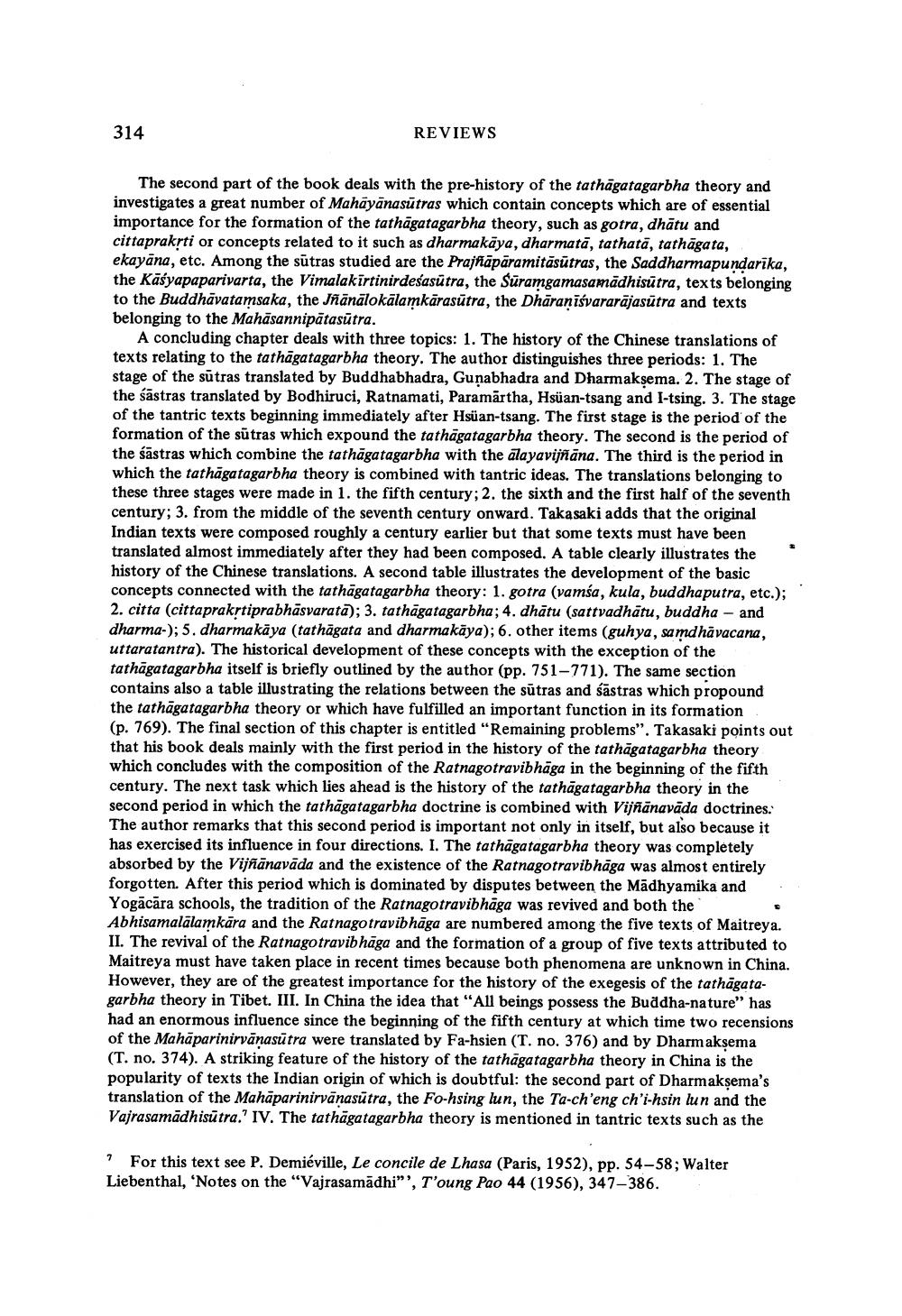________________
314
REVIEWS
The second part of the book deals with the pre-history of the tathāgatagarbha theory and investigates a great number of Mahāyānasūtras which contain concepts which are of essential importance for the formation of the tathāgatagarbha theory, such as gotra, dhātu and cittapraksti or concepts related to it such as dharmakāya, dharmatā, tathatā, tathāgata, ekayāna, etc. Among the sütras studied are the Prajñāpāramitāsūtras, the Saddharmapundarika, the Kāsyapaparivarta, the Vimalakirtinirdesasūtra, the Süramgamasamadhisútra, texts belonging to the Buddhāvatamsaka, the Jñānālokālamkārasūtra, the Dharanīśvararājasūtra and texts belonging to the Mahāsannipātasūtra.
A concluding chapter deals with three topics: 1. The history of the Chinese translations of texts relating to the tathāgatagarbha theory. The author distinguishes three periods: 1. The stage of the sūtras translated by Buddhabhadra, Gunabhadra and Dharmaksema. 2. The stage of the śāstras translated by Bodhiruci, Ratnamati, Paramartha, Hsüan-tsang and I-tsing. 3. The stage of the tantric texts beginning immediately after Hsüan-tsang. The first stage is the period of the formation of the sūtras which expound the tathāgatagarbha theory. The second is the period of the śāstras which combine the tathāgatagarbha with the alayavijñāna. The third is the period in which the tathāgatagarbha theory is combined with tantric ideas. The translations belonging to these three stages were made in 1. the fifth century; 2. the sixth and the first half of the seventh century; 3. from the middle of the seventh century onward. Takasaki adds that the original Indian texts were composed roughly a century earlier but that some texts must have been translated almost immediately after they had been composed. A table clearly illustrates the history of the Chinese translations. A second table illustrates the development of the basic concepts connected with the tathāgatagarbha theory: 1. gotra (vamsa, kula, buddhaputra, etc.); 2. citta (cittaprakrtiprabhāsvarata); 3. tathāgatagarbha; 4. dhātu (sattvadhātu, buddha - and dharma-); 5. dharmakāya (tathāgata and dharmakāya); 6. other items (guhya, samdhāvacana, uttaratantra). The historical development of these concepts with the exception of the tathāgatagarbha itself is briefly outlined by the author (pp. 751-771). The same section contains also a table illustrating the relations between the sūtras and śāstras which propound the tathāgatagarbha theory or which have fulfilled an important function in its formation (p. 769). The final section of this chapter is entitled "Remaining problems". Takasaki points out that his book deals mainly with the first period in the history of the tathāgatagarbha theory which concludes with the composition of the Ratnagotravibhāga in the beginning of the fifth century. The next task which lies ahead is the history of the tathāgatagarbha theory in the second period in which the tathāgatagarbha doctrine is combined with Vijñānavāda doctrines. The author remarks that this second period is important not only in itself, but also because it has exercised its influence in four directions. I. The tathāgatagarbha theory was completely absorbed by the Vijñānavāda and the existence of the Ratnagotravibhāga was almost entirely forgotten. After this period which is dominated by disputes between the Mādhyamika and Yogācāra schools, the tradition of the Ratnagotravibhāga was revived and both the Abhisamalalamkāra and the Ratnagotravibhāga are numbered among the five texts of Maitreya. II. The revival of the Ratnagotravibhāga and the formation of a group of five texts attributed to Maitreya must have taken place in recent times because both phenomena are unknown in China. However, they are of the greatest importance for the history of the exegesis of the tathāgatagarbha theory in Tibet. III. In China the idea that “All beings possess the Buddha-nature" has had an enormous influence since the beginning of the fifth century at which time two recensions of the Mahāparinirvānasūtra were translated by Fa-hsien (T. no. 376) and by Dharm aksema (T. no. 374). A striking feature of the history of the tathāgatagarbha theory in China is the popularity of texts the Indian origin of which is doubtful: the second part of Dharmaksema's translation of the Mahāparinirvanasūtra, the Fo-hsing lun, the Ta-ch'eng ch'i-hsin lun and the Vajrasamādhisūtra.' IV. The tathāgatagarbha theory is mentioned in tantric texts such as the
7 For this text see P. Demiéville, Le concile de Lhasa (Paris, 1952), pp. 54-58; Walter Liebenthal, 'Notes on the “Vajrasamādhi”, T'oung Pao 44 (1956), 347–386.




